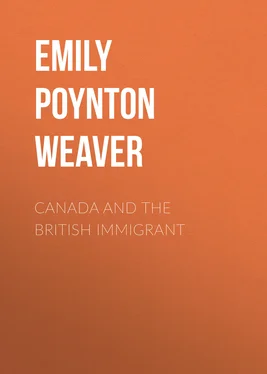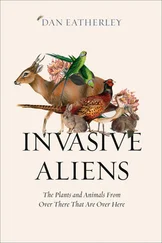Emily Poynton Weaver - Canada and the British immigrant
Здесь есть возможность читать онлайн «Emily Poynton Weaver - Canada and the British immigrant» — ознакомительный отрывок электронной книги совершенно бесплатно, а после прочтения отрывка купить полную версию. В некоторых случаях можно слушать аудио, скачать через торрент в формате fb2 и присутствует краткое содержание. Жанр: Путешествия и география, История, foreign_edu, foreign_antique, foreign_prose, на английском языке. Описание произведения, (предисловие) а так же отзывы посетителей доступны на портале библиотеки ЛибКат.
- Название:Canada and the British immigrant
- Автор:
- Жанр:
- Год:неизвестен
- ISBN:нет данных
- Рейтинг книги:3 / 5. Голосов: 1
-
Избранное:Добавить в избранное
- Отзывы:
-
Ваша оценка:
- 60
- 1
- 2
- 3
- 4
- 5
Canada and the British immigrant: краткое содержание, описание и аннотация
Предлагаем к чтению аннотацию, описание, краткое содержание или предисловие (зависит от того, что написал сам автор книги «Canada and the British immigrant»). Если вы не нашли необходимую информацию о книге — напишите в комментариях, мы постараемся отыскать её.
Canada and the British immigrant — читать онлайн ознакомительный отрывок
Ниже представлен текст книги, разбитый по страницам. Система сохранения места последней прочитанной страницы, позволяет с удобством читать онлайн бесплатно книгу «Canada and the British immigrant», без необходимости каждый раз заново искать на чём Вы остановились. Поставьте закладку, и сможете в любой момент перейти на страницу, на которой закончили чтение.
Интервал:
Закладка:
The second great industry of those depending directly on natural resources is lumbering. When the French settled on the St. Lawrence, they perceived at once the value of the forest wealth of the land, reporting to the home government that the colony would prove a rich source for the supply of masts and spars for the royal navy; and soon “stringent regulations were issued for the preservation of the standing oak.” The early British governors were also instructed to take measures for the preservation of lumber likely to be useful for the navy.
The export of Canada’s forest products began, it is said, in 1667, when the first shipload of lumber was sent to Europe. For years forest products came first in value on the list of exports. During the earlier part of the nineteenth century, Canada’s lumber went chiefly to Great Britain; but during the last forty years much has been exported to the United States. This has, however, been offset in part by considerable imports of American lumber into Canada.
In Canada there is, of course, an immense domestic demand for wood. Over half the people live in wooden houses, immense quantities of wood are still used as fuel, our thousands of miles of railway tracks are laid on wooden ties or “sleepers;” fleets of wooden ships and boats still ply on our coast and inland waters—in fact, it has been said that “our civilization is built on wood. From the cradle to the coffin in some shape or other it surrounds us as a convenience or necessity.” Our childhood’s toys, our furniture, the very paper on which the news of the day is printed, are forest products strangely transmuted. No sane person would dispute the value of the forests, and Canada is richly endowed in this respect; though, perhaps, hardly so richly as some estimates would lead us to believe.
In time past there has been most reckless waste of the Dominion’s forest wealth. In early pioneering days, perhaps it was unavoidable that the immigrants, far from markets, and hemmed in by great woods, should treat the trees as natural enemies, and clear them off the face of the earth as rapidly and as thoroughly as they could. So, in Ontario, were destroyed millions of magnificent trees; in many instances of kinds that would now be of immense value for the making of the better kinds of furniture; but black walnut trees were used to make fences of, and beeches and maples, too heavy to raft down the lakes to the seaports, as was done with the pine, were drawn together and burned in great heaps so that the settler could plant his first little crops of corn and vegetables amongst their stumps, and could turn an honest penny by selling the potash he made from their ashes.
Not only the pioneers, however, have been responsible for the destruction of trees. The Indians and hunters of game in the woods, the lumbermen, leaving their great heaps of dry brush and other inflammable refuse, only needing a chance spark from the lighting of a pipe, or a camp fire carelessly left burning, to turn it into kindling, ready laid for a great conflagration; the railways with the unguarded smoke stacks of their engines, have all had their share in the destruction of the forests; and it has been estimated that more timber has been destroyed in the Dominion by fire than by the axe. The nation is, however, awakening to the seriousness of the situation. For the last fourteen years the Canadian Forestry Association, with branches all over the Dominion, has been doing excellent work in disseminating information and rousing public interest concerning the preservation of the forests, and a new governmental policy has been inaugurated. Large areas of land have been set apart in Ontario and other provinces and by the Dominion government, where it has direct control, as “Forest Reserves.”
In 1909 there was established the non-partizan “Conservation Commission,” upon which each province is represented in the person of the cabinet minister most definitely connected with the administration of natural resources. Ontario’s representative, for instance, is the Minister of Lands and Mines. The several universities of Canada are also represented. The functions of the Commission are advisory and educational, and its members are carefully studying the various natural resources. But it is recognized that the people are the greatest asset the country possesses; and while the Commission endeavours to devise plans for avoiding wasteful methods in lumbering and mining, to prevent the depletion of the fish in the waters and the game in the woods, it is concerned above all to discover means of stopping the fearful waste of human life by industrial accidents, unhealthy conditions, preventable diseases, and the ignorant treatment of infants and young children, which last results in such appalling mortality in the first five years of life.
It must not, however, be inferred from this reference to infant mortality that the climate of Canada is by any means unhealthy. The experience of immigrants from the British Isles and from all European countries shows that it is well fitted for Europeans; and, as a general rule, the children especially enjoy the cold months, finding delight in the sports that winter brings. Often the snow is too firm and powdery for that favourite sport of British youngsters—snowballing! But little ones who have not long learned to toddle alone can find amusement with their small sleighs, and for bigger children and young boys and girls there are the endless delights of “coasting” and toboganning and skating and snow-shoeing and ski-ing.
Of course, here the country children have the best of it. But if one wants to realize the delights offered by a brisk winter’s day, he cannot do better than visit some open hilly spot within the limits of one of Canada’s cities—especially on a Saturday afternoon when the fathers have time to join in the fun. Then the white hillside is fairly alive with children in gay blanket-coats (often of scarlet) and knitted French-Canadian “tuques” ending in saucy bobs on the top, or long bag-like arrangements finished with dangling tassels; but it is the eagerness of the children and their quaint attitudes which give the picture its chief interest. A favourite way of making the descent is prone on the little sleighs, head foremost, legs stuck stiffly up from the knees, or trailing out behind, as an excellent rudder. Sometimes two “bob-sleighs,” connected by a long board, form a more ambitious vehicle for half a dozen boys and girls at once, and loud are the shrieks and the laughter, as the “bobs” jolt over some rough bit of the track or shoot their passengers off at last into some heap of snow. As a rule, the mothers see that the youngsters are warmly clad in woollen garments from head to heel, and then no one is hurt by a roll in the soft snow.
Конец ознакомительного фрагмента.
Текст предоставлен ООО «ЛитРес».
Прочитайте эту книгу целиком, купив полную легальную версию на ЛитРес.
Безопасно оплатить книгу можно банковской картой Visa, MasterCard, Maestro, со счета мобильного телефона, с платежного терминала, в салоне МТС или Связной, через PayPal, WebMoney, Яндекс.Деньги, QIWI Кошелек, бонусными картами или другим удобным Вам способом.
Интервал:
Закладка:
Похожие книги на «Canada and the British immigrant»
Представляем Вашему вниманию похожие книги на «Canada and the British immigrant» списком для выбора. Мы отобрали схожую по названию и смыслу литературу в надежде предоставить читателям больше вариантов отыскать новые, интересные, ещё непрочитанные произведения.
Обсуждение, отзывы о книге «Canada and the British immigrant» и просто собственные мнения читателей. Оставьте ваши комментарии, напишите, что Вы думаете о произведении, его смысле или главных героях. Укажите что конкретно понравилось, а что нет, и почему Вы так считаете.


![О Генри - Граф и свадебный гость [Черное платье] [The Count and the Wedding Guest]](/books/405331/o-genri-graf-i-svadebnyj-gost-chernoe-plate-th-thumb.webp)









